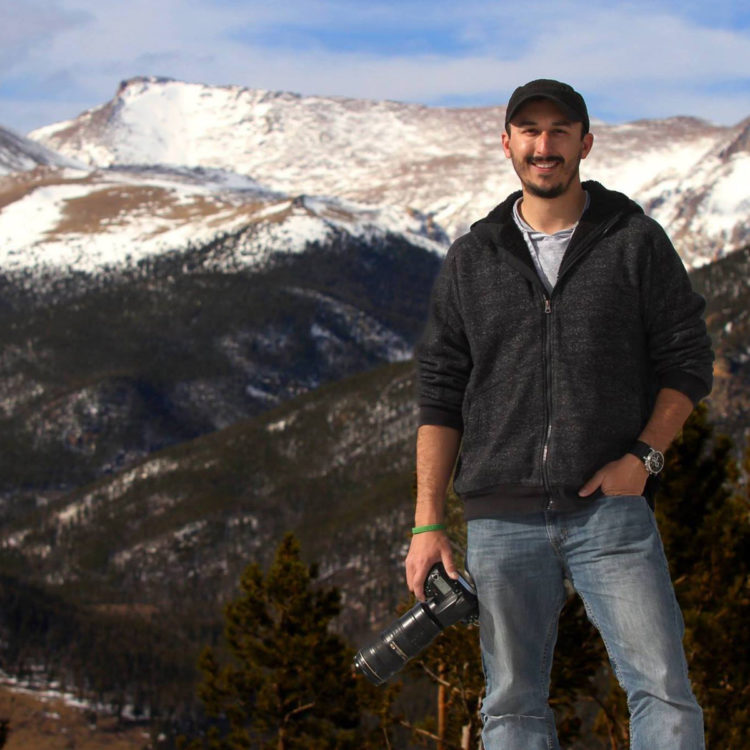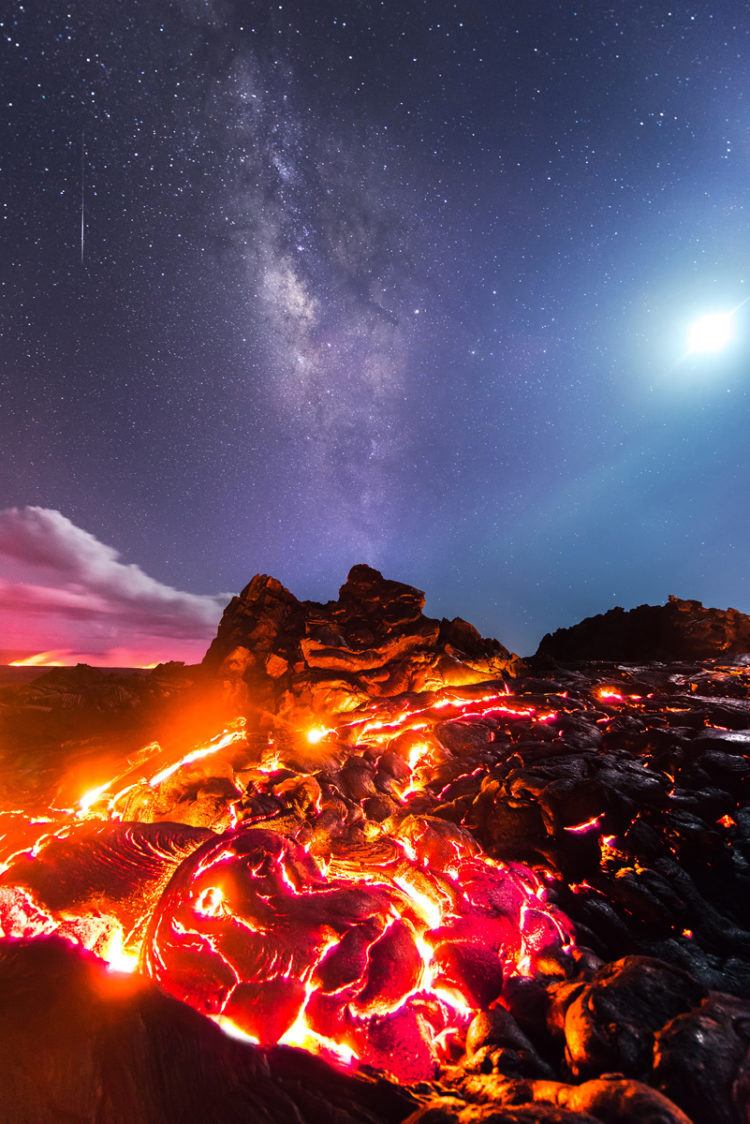
Capturing the Shot of a Lifetime
On July 26, 2016, after several weeks of slowly progressing miles down from the Puʻu ʻŌʻō vent on the Kilauea Volcano in Hawaii, lava entered the Pacific Ocean creating the world’s newest land. This was the first time in nearly three years that lava had returned to the ocean. It was a moment that I had waited oh so patiently for years on, and when it happened, the frantic search for flights began. Photographing an active volcano was the number two item on my bucket list, right under photographing the aurora borealis.
Unfortunately, money was a bit tighter than I had hoped for at the time, and with a few previously planned trips to teach, it looked like my excursion wouldn’t be able to happen for at least a month. It was an extremely hard pill to swallow. Would the lava still be flowing in a month? Would I miss capturing the shot I waited years for? Who knew, but I have always believed that everything happens for a reason and patience pays off.
In early September, I was finally able to catch a flight out to the Big Island in hopes of seeing the lava ocean entry up close and personal. During that painstaking month of waiting, I did an ample amount of research on how to safely approach the ocean entry from both land and sea. Needless to say, both were dangerous, and to be honest, I was never very good at the game “the floor is lava,” when I was a kid. There was definitely a bit of anxiety and fear on my behalf when the time came to actually head out to the lava flow.
With only three days to be able to visit the 61G lava flow, I put together a shot list of what I hoped on capturing. It was quite simple, nothing out of the ordinary, nothing like what I captured on one of my last frames out in the field. I honestly just wanted a nice long exposure of the ocean entry, a close up shot from the boat, and some sort of surface flow with a nice sunset. I wasn’t asking for much in my opinion.
On the first two days, I was able to document the lava entering the ocean from the cliffs near Kalapana, as well as from the ocean thanks to a ride from Ocean Lava Tours and Captain Shane. During those days out though, surface flows were non-existent except for a distant flow just coming down the Pulama Pali, a good couple of miles away from the ocean entry. That area was my only chance of being able to get close on foot to the lava, as any chance to get close to the surface flows going over the cliffs was impossible due to the area being closed off for safety reasons. The hike was going to be long and included crossing some areas that may still be hot from recent flows, vents with volcanic gases, and collapsed lava tubes. Needless to say, it had its risks. After consulting with some local photographers and national park rangers about the trip out there, I felt I had enough of an understanding on how to safely make the trip.
On the evening of the last day of the trip, it was go time. The trek began with a four-mile bike ride down the emergency access road from Kalapana to the ocean entry point. After that, it was another two-and-a-half mile hike across the old lava flows where with every few steps, you risked twisting an ankle or falling and getting cut (which happened several times). Once the bottom of the Pali was reached, almost all hope was lost as the lava that was seen coming down that morning, was nowhere to be found. I used a pair of binoculars to scope out the area in hopes of seeing even the smallest of red glow coming from somewhere accessible.
About fifteen minutes into searching, it happened, a small breakout about 300 yards away grabbed my eye. It wasn’t the river of lava that I was hoping for but dang it, it was lava. I quickly made my way across the terrain and when I turned the corner around an area of uplifted lava rock, I was greeted with the crackling sound and scorching heat of a slow moving surface flow. The lava, at nearly 2300ºF, was so hot that I could only stand within a few feet of it for about five seconds before the hairs on my legs would begin to singe. It was an amazing moment to see something so beautiful and powerful, right there in front of me. I began to shoot away and as daylight faded, the fiery sunset I was hoping for was nowhere to be found, as the sky was cloudless from horizon to horizon. I was left longing for a more interesting shot than just a surface flow with a blank sky.
In the world of a landscape photographer, many of us know that it is a love/hate relationship with clouds. We want clouds for that stunning sunset, but then we want clear skies for our astrophotography images. With the clear skies available for the taking, I decided that it would be nice to try and create an image with some stars above the lava. After analyzing the sky, I noticed that there was a small crescent moon off to the southwest and it was still Milky Way season, so the celestial center should be off to the south somewhere. The question on my mind though was, would the crescent moon be too close to the Milky Way and wash it out, or would it be the perfect amount of light to add a nice element to the sky while being able to retain detail in the Milky Way core?
As twilight faded, I began to set up my composition and quickly realized another issue. The surface flow in front of me was way too bright and I wouldn’t be able to properly expose for both the Milky Way and lava in one frame. As easy as it would be to shoot the image in two parts, one for the Milky Way and one for the lava, I didn’t want a blended image if I could avoid it. I decided to move away from the larger surface flow breakout and towards the area of the lava that was cooling but still had a glow from just beneath the crust. This worked out perfectly.
The lava was bright enough to show through the cracks in a vibrant red color, all the while allowing the night sky to come through beautifully. I rattled off my first frame and then encountered another problem. The glow from the larger surface flow area was too bright and was flaring my frame so badly that the image wouldn’t be useable. I was shooting on a Nikon 14-24mm lens, so there was no lens hood, which meant I had to create one myself. All I did was simply stand a few feet to the left of my lens and positioned myself until my shadow covered the front element of my lens, and boom…human lens hood.
I rattled off my second image and noticed that I needed to move just a tad further back to be completely out of my frame, but besides that, everything was technically exactly where I wanted it to be. I took note of where I should stand, triggered my timer on my camera, and then stepped into position. The shutter opened and I took in the moment. Listening to the lava crackle like Rice Krispies, the moon and Milky Way shining above, and then in the blink of an eye, I saw a meteor streak across the sky. It was too good to be true and I almost ran to my camera to see if I captured it all before the shutter closed. Thankfully, I caught myself before I moved, which would have resulted in the whole image being lost due to that evil lava flare.
When I heard the shutter close, I quickly ran over and waited for the noise reduction to render out. After what seemed to be the longest 25 seconds ever, the LCD lit up with the image and had all the elements there, perfectly tack sharp. An active lava flow glowing up from the surface, the moon shining above, the Milky Way glowing brightly, and a meteor streaking through starry night sky. I couldn’t believe my eyes and I knew I couldn’t top that shot, no matter how long I stayed out that night. So with that said, I packed up my gear and began the long seven-mile trek back.

After posting the image online, the shot went viral. It was published all around the world, including National Geographic – Russia. With the image getting so much attention, comments and messages began rolling in questioning the reality of the image and claiming that even if it were real, there would be no way possible to capture all those elements and differences in light in one shot. Well, as the guy who melted part of his shoes off while standing as a human lens hood near 2300ºF lava, I can attest…it is 100% real and 100% possible. It simply took an understanding of light and how to work with it. Oh yeah, and a little bit of luck and dedication.
The image you see here was shot at f/2.8, ISO 2500, and 25” shutter. Basically the settings that were needed to properly expose for the night sky. For post processing, minimal adjustments were made. I corrected the white balance, added a bit of clarity and contrast, and did a bit of dodging and burning. I hope this article enlightens you all to how this image came to life with so much planning before the shutter was even clicked.
You can see more of Mike’s work at MikeMezPhotography.com, and follow him on Instagram, Facebook, and Twitter.




Congrats Mike! That is one awesome shot – will probably one of your top 5 at the end of your career. Thanks for sharing the story and the technique – well done!
This image was viral on social media. Lots of friends of mine had posted it on their social media profile. It was really excellent shoot. Thanks for sharing you experience here.
Incredible shot. Thanks for the behind the scenes story.
Amazing. I finally read this today. When I saw the top of the image, I waited till I did read the rest of the story before I looked, similar to not reading the last chapter of a killer novel. I am glad I waited. OMG what an image!